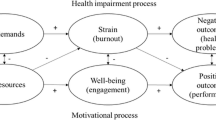Abstract
Prison officers not only affect prison operations, but correctional workplace variables also have effects on officers. Most of the past empirical research on this topic has focused on officers working in Western prisons. This study used the job demands–resources model to examine the effects of workplace variables in terms of job demands (e.g., perceived dangerousness of the job and role overload) and job resources (e.g., job autonomy, job variety, instrumental communication, and quality supervision) on job involvement among Indian prison officers using a sample of 163 prison officers from a prison in the state of Haryana in India. OLS regression indicated role overload, job autonomy, and instrumental communication all had nonsignificant effects, while job variety and quality supervision had positive effects on job involvement, as did the job demand of perceived dangerousness of the job. Similar to past research, the positive effects of job variety and quality supervision appear to be universal across prisons, as are the lack of direct effects for role overload and instrumental communication. Conversely, the effects of perceived dangerousness of the job and job autonomy appear to be contextual, varying across prisons in different nations.
Similar content being viewed by others
Notes
It was noted during the review process that as only 7% of the participants were women and that, therefore, gender could be dropped from the regression analysis. The OLS regression equation was re-estimated without the gender variable. The results were similar in terms of the amount of variance explained, the significant predictors, and the ranking of the significant variables in terms of the size of their standardized regression coefficients. The R2 for this new regression model was .47 (p ≤ .01), and the significant predictors were educational level (β = − .20, p ≤ .01), perceived dangerousness of the job (β = .17, p ≤ .01), quality supervision (β = .19, p ≤ .01), and job variety (β = .49, p ≤ .01). Job variety continued to have the largest-sized effect, more than twice that of any other significant independent variable.
This point was raised by a reviewer. We thank both reviewers for reviewing the manuscript. Their insightful comments and suggestions improved the manuscript.
References
Bahl, S. (2017, August 24). Prison laws in India—The forgotten law. IPleaders. https://blog.ipleaders.in/prison-laws-india/
Bakker, A. B., & Demerouti, E. (2017). Job demands–resources theory: Taking stock and looking forward. Journal of Occupational Health Psychology, 22, 273–285.
Bakker, A. B., Demerouti, E., de Boer, E., & Schaufeli, W. B. (2003). Job demands and job resources as predictors of absence duration and frequency. Journal of Vocational Behavior, 62, 341–356.
Berry, W. D. (1993). Understanding regression assumptions. SAGE Publications.
Bhutta, M. H., & Akbar, M. S. (2012). Situation of prisons in India and Pakistan: Shared legacy, same challenges. South Asian Studies, 27(1), 171–181.
Blau, G., & Boal, K. (1989). Using job involvement and organizational commitment interactively to predict turnover. Journal of Management, 15, 115–127.
Brown, S. P., & Leigh, T. W. (1996). A new look at psychological climate and its relationship to job involvement, effort, and performance. Journal of Applied Psychology, 81, 358–368.
Census2011.co.in. (2015). Haryana population census data 2011. http://www.census2011.co.in/census/state/haryana.html.
Chen, C.-C., & Chiu, S.-F. (2009). The mediating role of job involvement in the relationship between job characteristics and organizational citizenship behavior. The Journal of Social Psychology, 149, 474–494.
Cohen, J. (1988). Statistical power analysis for the behavioral sciences (2nd ed.). Erlbaum.
Cullen, F. T., Link, B. G., Wolfe, N. T., & Frank, J. (1985). The social dimensions of correctional officer stress. Justice Quarterly, 2, 505–533.
Curry, J. P., Wakefield, D. S., Price, J. L., & Mueller, C. W. (1986). On the causal ordering of job satisfaction and organizational commitment. Academy of Management Journal, 29, 847–858.
DeCarufel, A., & Schaan, J.-L. (1990). The impact of compressed work weeks on police job involvement. Canadian Police College Journal, 14, 81–97.
Demerouti, E., Bakker, A., Nachreiner, F., & Schaufeli, W. (2001). The job demands–resources model of burnout. Journal of Applied Psychology, 86, 499–512.
Dhanuka, M., & Lamba, S. (2020, January 25). India’s prison system needs urgent reform. Hindustan Times. https://www.humanrightsinitiative.org/in-the-news/indias-prison-system-needs-urgent-reform
Ellis, P. D. (2010). The essential guide to effect sizes: Statistical power, meta-analysis, and the interpretation of research results. Cambridge University Press.
Gorsuch, R. L. (1983). Factor analysis (2nd ed.). Lawrence Erlbaum.
Griffin, M. L., Hogan, N. L., & Lambert, E. G. (2012). Doing “people work” in the prison setting: An examination of the job characteristics model and correctional staff burnout. Criminal Justice and Behavior, 39, 1131–1147.
Haryana Prisons. (2022). Government of Haryana. http://haryanaprisons.gov.in/
Jowell, R. (1998). How comparative is comparative research? American Behavioral Scientist, 42, 168–177.
Jurik, N. C., Halemba, G. J., Musheno, M. C., & Boyle, B. V. (1987). Educational attainment, job satisfaction, and the professionalization of correctional officers. Work and Occupations, 14, 106–125.
Kanungo, R. N. (1982). Work alienation: An integrative approach. Praeger.
Lambert, E. G. (2004). The impact of job characteristics on correctional staff members. The Prison Journal, 84, 208–227.
Lambert, E. G., Hogan, N. L., Cheeseman, K., & Barton-Bellesa, S. M. (2013). The relationship between job stressors and job involvement among correctional staff: A test of the job strain model. The Howard Journal of Criminal Justice, 52, 19–38.
Lambert, E. G., Hogan, N. L., Cheeseman Dial, K., Altheimer, I., & Barton-Bellessa, S. M. (2012). Examining the effects of stressors on organizational citizenship behaviors among private correctional staff: A preliminary study. Security Journal, 25, 152–172.
Lambert, E. G., Hogan, N. L., Paoline, E. A., & Baker, D. N. (2005). The good life: The impact of job satisfaction and occupational stressors on correctional staff life satisfaction—An exploratory study. Journal of Crime and Justice, 28, 1–26.
Lambert, E. G., Liu, J., Jiang, S., Zhang, J., & Kelley, T. M. (2018). The antecedents of job involvement: An exploratory study among Chinese prison staff. International Journal of Law, Crime and Justice, 54, 21–33.
Lambert, E. G., & Paoline, E. A. (2012). Exploring potential antecedents of job involvement: An exploratory study among jail staff. Criminal Justice and Behavior, 39, 264–286.
Lawler, E. E., & Hall, D. T. (1970). Relationship of job characteristics to job involvement, satisfaction, and intrinsic motivation. Journal of Applied Psychology, 54, 305–312.
Lindsay, R. M., & Ehrenberg, A. S. (1993). The design of replicated studies. The American Statistician, 47, 217–228.
Lodahl, T. M., & Kejner, M. (1965). The definition and measurement of job involvement. Journal of Applied Psychology, 49, 24–33.
Mauno, S., Kinnunen, U., & Ruokolainen, M. (2006). Exploring work- and organization-based resources as moderators between work–family conflict, well-being, and job attitudes. Work and Stress, 20, 210–233.
Mertler, C. A., & Vannatta, R. A. (2005). Advanced and multivariate statistical methods: Practical application and interpretation (4th ed.). Pyrczak.
Namdev, A. (2019). Types of prisons in India. MyIndia. Retrieved November 11, 2021, from https://www.mapsofindia.com/my-india/government/types-of-prisons-in-india
NCRB. (2021). National Crime Records Bureau (NCRB) Report. NCRB. https://ncrb.gov.in/sites/default/files/psi_table_and_chapter_report/Chapter-11-2020.pdf
Otu, S. E., Lambert, E. G., & Elechi, O. O. (2020). Testing the job demands–resources model for Nigerian prison staff job involvement. Corrections. https://doi.org/10.1080/23774657.2020.1800434 Online first.
Paoline, E. A., Lambert, E. G., Hogan, N. L., & Keena, L. D. (2018). The effects of the workplace on jail staff: The issue of perceptions of pay fairness. Corrections: Policy Practice, and Research, 3, 203–224.
Prisons Statistics India 2019. (2020). National Crime Records Bureau, Ministry of Home Affairs. http://ncrb.gov.in/
Santhosh, R., & Mathew, E. (2021). Social reintegration of released prisoners: An empirical analysis from two Indian states. International Annals of Criminology, 59, 200–222.
Schaufeli, W. B., & Taris, T. W. (2014). A critical review of the job demands–resources model: Implications for improving work and health. In G. Bauer & O. Hammig (Eds.), Bridging occupational, organizational and public health (pp. 43–68). Springer.
Tabachnick, B. G., & Fidell, L. S. (2019). Using multivariate statistics (7th ed.). Pearson.
Triplett, R., Mullings, J. L., & Scarborough, K. E. (1996). Work-related stress and coping among correctional officers: Implications from organizational literature. Journal of Criminal Justice, 24, 291–308.
Waits, M. R. (2018). Imperial vision, colonial prisons: British jails in Bengal, 1823–73. Journal of the Society of Architectural Historians, 77(2), 146–167.
World Factbook. (2021). India. Retrieved November 10, 2021, from https://www.cia.gov/the-world-factbook/countries/india/
World Prison Brief. (2021). India. https://www.prisonstudies.org/country/india
Acknowledgements
The authors thank the editor, editorial staff, and reviewers for their comments and suggestions. These comments and suggestions improved the paper.
Author information
Authors and Affiliations
Corresponding author
Ethics declarations
Conflict of interest
The authors had no conflict of interest with this study.
Ethical Approval
The study had human subjects approval and followed ethical guidelines.
Appendix
Appendix
Below are the items used to measure the latent variables in this study. Except for instrumental communication, the items were answered using a six-point Likert scale of 1 = strongly disagree, 2 = disagree, 3 = somewhat disagree, 4 = somewhat agree, 5 = agree, and 6 = strongly agree. The response options for the instrumental communication items were 1 = not informed, 2 = informed very little, 3 = informed somewhat, 4 = informed, and 5 = very well informed.
Job Involvement (1) I live, eat, and breathe my job (i.e., my job is very important to me; (2) The major satisfaction in my life comes from work; and (3) The most important things that happen to me in my life usually occur at work.
Perceived Dangerousness of the Job (1) I work at a dangerous job; (2) My job is a lot more dangerous than most jobs in the community; and (3) At my job, there is a real risk of being hurt or injured.
Role Overload (1) I often receive an assignment without adequate resources and materials to get it done; (2) I am responsible for almost an unmanageable number of assignments and job duties; and (3) I consider myself overworked on my job.
Instrumental Communication How informed are you by the correctional organization about the following aspects of your job: (1) What is to be done; (2) What is most important about the job; (3) How the equipment is used; (4) Rules and regulations; and (5) What you need to know to do the job correctly.
Job Autonomy (1) I have flexibility in how and when to do my job duties; and (2) I have a great deal of say in how my job is done.
Job Variety (1) My job requires that I must constantly learn new things; (2) My job requires that I be very creative; and (3) My job has a lot of variety in it.
Quality of Supervision (1) My supervisor gives me advance notice of changes; (2) My supervisor looks out for my personal welfare; (3) When decisions are made by my supervisor, persons affected are asked for their ideas; and (4) My supervisor is friendly and approachable.
Rights and permissions
Springer Nature or its licensor holds exclusive rights to this article under a publishing agreement with the author(s) or other rightsholder(s); author self-archiving of the accepted manuscript version of this article is solely governed by the terms of such publishing agreement and applicable law.
About this article
Cite this article
Lambert, E.G., Qureshi, H., Frank, J. et al. The Effects of Work Demand and Resource Variables on Indian Prison Staff Job Involvement. Int Criminol 2, 424–436 (2022). https://doi.org/10.1007/s43576-022-00063-0
Received:
Accepted:
Published:
Issue Date:
DOI: https://doi.org/10.1007/s43576-022-00063-0




